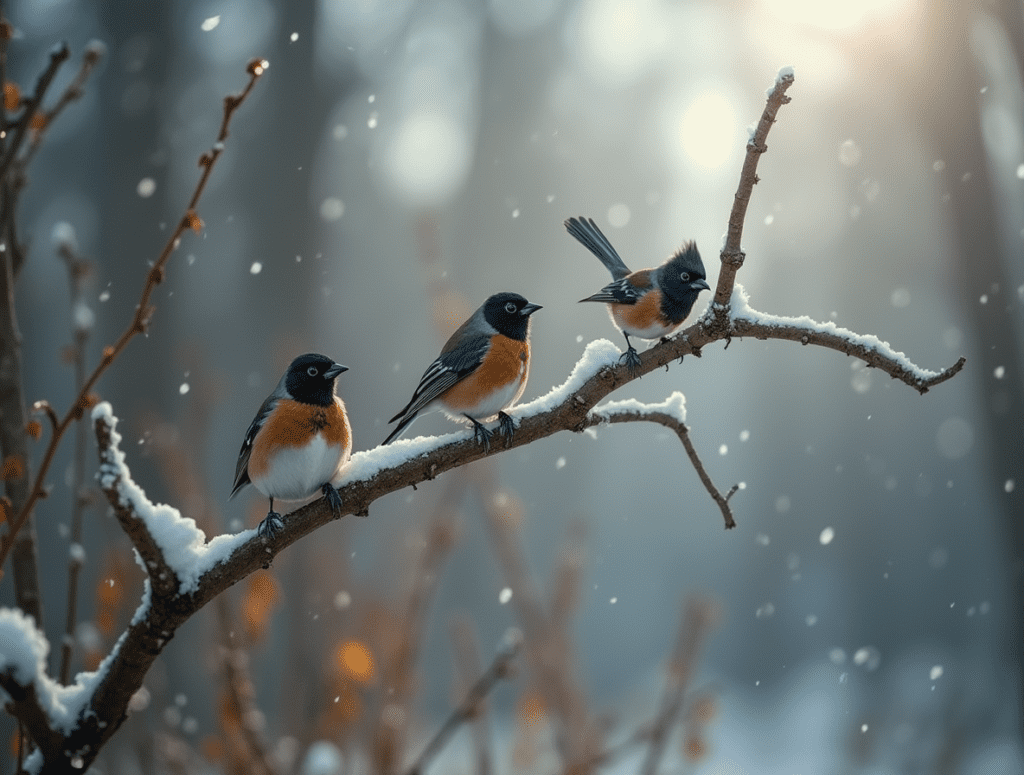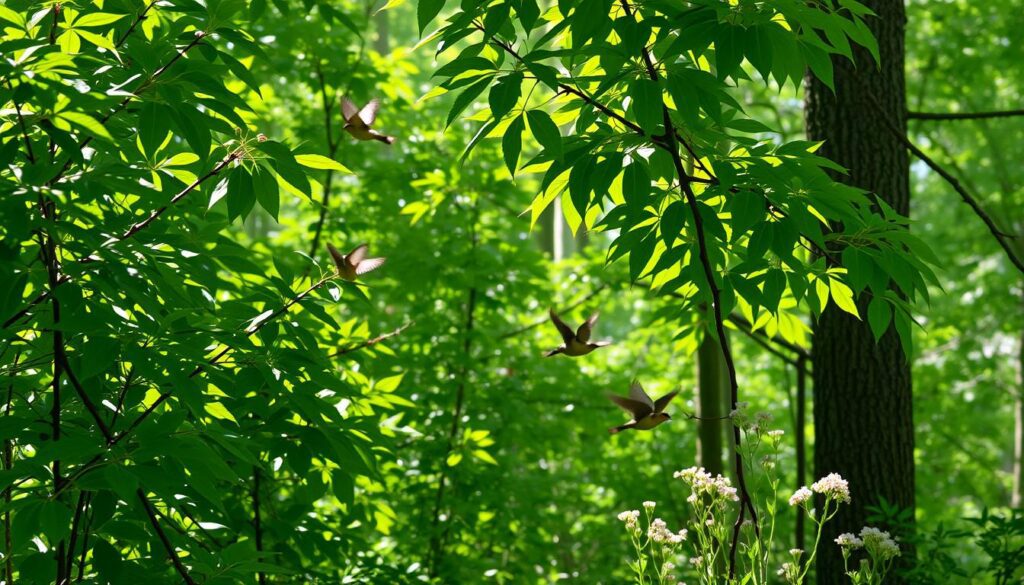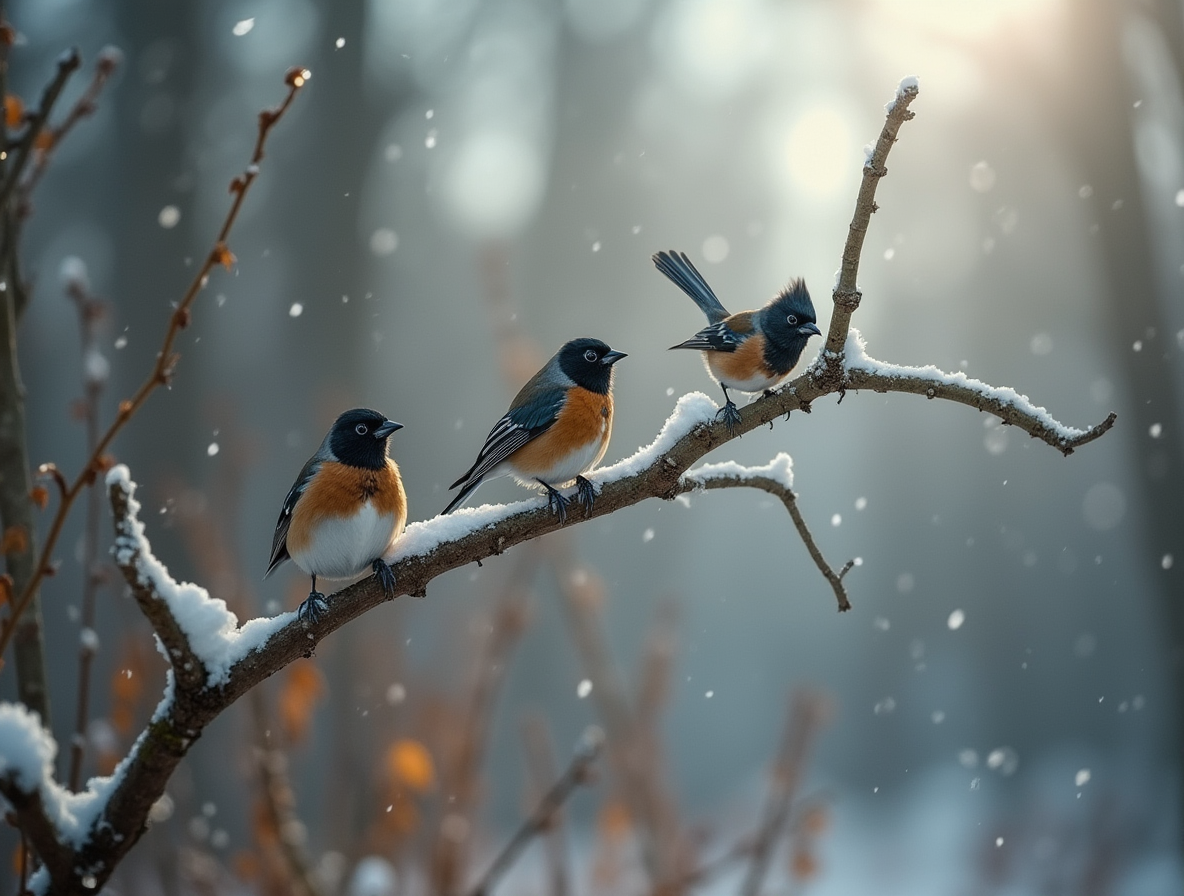Exploring the Migration Patterns of Woodland Birds
Standing under the trees, you might hear leaves rustling and birds calling. Have you thought about their amazing journeys? Every spring and fall, millions of birds fly long distances. They do this to survive, following their instincts.
These journeys are not just physical. They are emotional, showing us nature’s balance. This guide will show you the amazing patterns of woodland bird migrations. You’ll learn about their connection to their habitats and how to help protect them.

Understanding Bird Migration
Bird migration is a natural wonder where birds move from one place to another. They search for food, nesting sites, and better weather. Some birds, like the Bewick’s swan, travel over 2,500 miles from Siberia to the UK. This shows how far birds go to survive.
Every year, about 50 bird species leave the UK for warmer places. The UK is home to 90,000 Barnacle geese and 300,000 Pink-footed geese. These birds show how important food and habitat are during different seasons.
Some birds, like the Arctic tern, migrate to Antarctica. Young birds may even fly in the opposite direction as they learn. Climate change is changing when and how birds migrate, forcing them to adjust.
Learning about bird migration helps us appreciate nature and its changes. It shows how birds adapt to their environment.
Table of Contents
What Woodland Birds Migrate
In the United States, many woodland birds migrate with the seasons. Knowing which birds migrate is key to protecting their homes. Birds like songbirds and the American Robin are among these migrants. They have different migration patterns and times, which help them survive and reproduce.
Common Woodland Migrants
Woodland areas are home to many migrating birds. Some well-known ones are:
- Wood Duck – Known for its striking appearance and adaptability.
- American Robin – A familiar sight in gardens during spring.
- Blackburnian Warbler – Famous for its vibrant plumage.
- Bay-breasted Warbler – Notable for its distinctive breeding colors.
Migration Timing and Seasonal Patterns
Woodland birds migrate at specific times of the year. They leave their breeding grounds in late summer or early autumn. Then, they return in spring to find food and breed. Several factors influence their migration timing:
- Weather Conditions – Birds often respond to temperature changes and storm patterns.
- Food Availability – Fluctuations in food sources play a significant role in their travel plans.
- Reproductive Cycles – The breeding needs of each species dictate when they migrate.
Interestingly, birds adapt by eating more before migration. This helps them travel successfully. The complexity of bird migration shows why we must protect their habitats and understand their ecology.
The Importance of Woodland Habitats for Migratory Birds
Woodland habitats are key for migratory birds, offering food, shelter, and places to breed. These areas are vital for birds to rest and refuel on their long journeys. Knowing how important these habitats are helps protect and conserve them.
Many migratory birds depend on woodlands. These areas help them avoid dangers from urban growth and broken habitats. They support a variety of species, from red crabs to tree frogs, by keeping ecosystems connected.
- Wildlife corridors help endangered birds and other species move safely.
- Wetlands are crucial stops for birds like geese and storks, providing vital resources.
- Forested regions are home to many birds, including the Blackpoll Warbler, during their migrations.
It’s vital to protect these woodland habitats. Groups like the NYC Bird Alliance work to save places like Central Park’s woodlands. Their efforts help ensure future generations can see the variety of species that depend on these habitats.
| Resource | Benefit to Migratory Birds |
|---|---|
| Food Sources | Supports energy needs during migration |
| Shelter | Provides protection from predators and harsh weather |
| Nesting Sites | Enables successful reproduction during migratory seasons |
| Connected Habitats | Facilitates safe passage and access to resources |
Understanding the role of habitats for migratory birds helps us appreciate their amazing journeys. It also motivates us to protect woodlands. When exploring local areas, think about how you can help these vital environments. This ensures they stay welcoming for a wide range of bird species.
Types of Migrating Birds in Forests
Learning about the different birds in forests helps us understand ecosystems better. Migratory birds, like songbirds and waterfowl, are key to these habitats. Their migrations show how adaptable and dependent on various environments they are.
Songbirds and Their Migration Strategies
Songbirds, or warblers, have special migration ways. They travel long distances, eating insects and fruits in forests. This food is crucial for their energy.
They migrate at night to avoid predators and find food. This shows how forests are essential for their survival.
Waterfowl and Their Forest Habitats
Waterfowl, like Wood Ducks and Northern Pintails, are important in forests. They need specific habitats near water to nest. They nest in tree cavities or dense vegetation.
This shows how ecosystems support their needs. Their migration patterns highlight the role of forests in their success.
Woodland Bird Migration Patterns
Woodland birds migrate in amazing ways. They follow set paths that help them survive. Along these paths, they face many challenges due to different environmental factors.
Seasonal Migration Routes
The Eurasian Blackcap is a great example of migration routes. In Central Europe, a line at 14° separates their migration paths. The southwestern birds start their journey north in March.
They reach Western Europe and the British Isles by early April. Southeastern birds travel through the Middle East from late March to late May. They are most seen in mid-May.
The number of Eurasian Blackcaps seen has grown from just tens in 1950 to about 25,000 today. Birds from the southwestern migration reach North Atlantic islands by September. They get to Iceland by October-November.
Factors Influencing Migration
Weather, climate, and food are key to woodland birds’ survival. They use environmental signs like temperature and daylight to decide when to migrate. Climate change makes migration harder by changing food and paths.
This has made some birds migrate earlier or later than before. In the British Isles, some birds now go to southern Spain and North Africa for winter.
| Species | Migration Start | Peak Arrival | Key Challenges |
|---|---|---|---|
| Eurasian Blackcap | March | Late August – Early September | Climate change, food scarcity |
| Wood Ducks | Late September | Early October | Habitat loss, hunting |
| European Turtle-dove | Spring | Late April – Early May | Illegal hunting, habitat degradation |
Woodland Bird Migration Routes
Exploring the paths of migrating birds shows their amazing navigational skills. These skills are crucial for their survival as they migrate long distances. Birds use the Earth’s magnetic field, environmental cues, and even the stars to navigate. This helps them follow specific paths and reach their seasonal homes.
Navigational Skills of Migrating Birds
Migrating birds have incredible navigational abilities. They use a mix of instinct and learned experience to find their way. Birds use several methods to stay on course, including:
- Celestial Navigation: They use the sun and stars to guide their flight.
- Landmarks: They use geographical features like mountains and rivers.
- Earth’s Magnetic Field: They are sensitive to magnetic fields to keep direction.
- Olfactory Cues: Some species use scents to navigate their routes.
Major Flyways and Migratory Paths
Major migratory flyways are key routes for many bird species. These routes connect their breeding and wintering habitats. For example, the Great Atlantic Flyway helps millions of songbirds migrate north. When watching these routes, you’ll see many birds following specific paths. Key facts include:
| Flyway | Key Species | Migration Timing |
|---|---|---|
| Pacific Flyway | Western Sandpipers, Snow Geese | Late September to November |
| Central Flyway | Platte River Sandhill Cranes | March through April |
| Mississippi Flyway | Wood Ducks, American Robins | Late February to May |
| Great Atlantic Flyway | Blackpoll Warblers, Scarlet Tanagers | April through June |
Why Do Birds Migrate Through Woodlands?
Migratory birds move through woodlands in search of the best conditions for survival. They look for places with plenty of food and safe spots to breed. The changing climate plays a big role in their journey, guiding their paths and survival tactics.
Food Availability and Breeding Sites
In spring, birds return to woodlands for food and nesting sites. These areas are full of insects and plants that help them feed and raise their young. The abundance of food is key to their success in breeding.
Their breeding success depends on when they arrive and the environment’s ability to provide enough resources. This is influenced by various environmental factors.
Climate and Environmental Factors
Weather and temperature changes are crucial in shaping migration patterns. Warmer winters let birds stay longer in breeding areas, leading to earlier breeding. But, climate change can disrupt these patterns.
Birds may have to change their migration times to adapt to new habitats and food sources. This ensures their survival in the face of environmental challenges.
| Environmental Factor | Impact on Migration | Examples |
|---|---|---|
| Temperature Changes | Influences migration timing | Earlier arrival in spring |
| Precipitation Levels | Affects food availability | Changes in aquatic insect populations |
| Habitat Quality | Determines breeding success | Availability of nesting sites/Trees |
| Climate Patterns | Shifts migration routes | Storms affecting migration paths |
Notable Bird Species That Migrate Through Woodlands
Woodland ecosystems are home to a variety of bird species. Migratory wood warblers are a key part of this diversity. They build their nests high up in trees, where it’s safe and food is plentiful.
Their bright colors are a sign of a healthy woodland. These birds need lots of insects to survive, which they find in the woodlands.
Nesting Habits of Migratory Wood Warblers
Wood warblers are very good at finding the right place to nest. Every spring, they return to North America to start their families. They build their nests in the leaves of tall trees.
This keeps them safe from predators and close to food. How well they nest affects their chances of raising a family.
Unique Migration Challenges for Certain Species
Not all birds have it easy when they migrate. Some, like the Black-throated Blue Warbler, face big challenges. They lose their homes and struggle to find food.
Predators and less food make things even harder. We need to help protect their paths and places to rest.

Seasonal Migration of Woodland Birds
The seasonal migration of birds is key to healthy ecosystems and species survival. Birdwatchers and conservationists can better appreciate these journeys by understanding arrival and departure patterns. Woodland birds travel long distances each year, guided by environmental cues and food availability.
Patterns of Arrival and Departure
Woodland birds migrate at different times. Wheatears arrive in the UK by late February or early March. Nightjars, however, take longer, reaching their habitats in late April or May. The Arctic Tern’s 22,000-mile journey from the Antarctic to the UK and back is remarkable.
Cuckoos, on the other hand, spend only six weeks in the UK before migrating to tropical Africa.
Timing of the Migration Process
The migration process for woodland birds includes arrival, rest, feeding, and departure. In the contiguous U.S., the peak migration times are from March 1 to June 15 in spring and from August 1 to November 30 in fall. During these periods, birds aim to use energy efficiently for a successful journey.
Several factors, like geographical variations, climate change, and food availability, affect their migration. Cities often see peak migration phases, showing common routes and patterns for these travelers.
Climate Change and Its Impact on Woodland Birds
Climate change affects woodland birds in big ways. It changes how they migrate and live in their habitats. Birds now migrate earlier or take different routes because of climate change. This disrupts their habits and makes survival harder.
Changes in Migration Patterns
Studies show that over 80% of bird species’ changes match climate change predictions. Birds are laying eggs 5.1 days earlier each decade. In the western U.S., migration timing is linked to air and ocean temperatures.
Warmer winters and springs mean birds in places like Minnesota breed and stay longer. But, changing habitats pose big challenges to their success.
Effects on Bird Populations and Habitat
Climate change does more than just change when birds migrate. A 1°C rise in winter temperatures can reduce migratory species. But, warmer springs can increase migration numbers.
This can lead to more competition among non-migratory birds. As a result, migratory birds spend more time away from breeding grounds. This is due to the big climate-related changes.
How to Observe Migratory Woodland Birds
Birdwatching is exciting and rewarding, especially during migration seasons. To spot migratory woodland birds, know the best times and places. Early mornings and late afternoons are the best times for birdwatching.
Best Times and Locations for Birdwatching
Urban parks, nature reserves, and national parks are great for spotting migratory birds. Central Park is a top spot with over 210 bird species. You might see gray catbirds and barn swallows during their migrations.
Van Cortlandt Park is also excellent, with about 230 bird species. It has important habitats for birdwatching.
Equipment and Techniques for Effective Birdwatching
The right equipment makes birdwatching better. You’ll need:
- Binoculars for close-up views
- Field guides for identifying birds
- Cameras for capturing moments
To improve your birdwatching, stay quiet and use natural cover. Watching their behavior helps identify species. Knowing bird calls can also help find migrants.
During nesting season, keep your distance from nests. This avoids disturbing young birds. Fledglings may come close as they learn to fly.
Here’s a table with the best times and places for birdwatching in key parks:
| Park | Best Birdwatching Times | Key Species |
|---|---|---|
| Central Park | Early mornings, late afternoons | Gray Catbird, Barn Swallow |
| Van Cortlandt Park | Early mornings, spring/fall migrations | Warblers, Red-tailed Hawk |
Conservation Efforts for Migratory Birds
It’s crucial to protect migratory birds as their habitats get worse. We must protect their homes and teach people to live sustainably. This includes fixing damaged habitats and spreading the word about their importance.
Protecting Habitats and Natural Resources
Urban growth and land use changes harm migratory bird habitats. Places like Poyang Lake are losing quality. We’ve seen fewer safe paths for birds over the years.
Thanks to funding, like $87 million for bird conservation, we’re making progress. We’ve saved over 300,000 acres of land for birds in North America. In southwest Washington, we’ve protected 1,600 acres of bird habitats.
In Southcentral Alaska, we’ve saved about 1,140 acres of wetlands. The Willapa and Chehalis Wetlands project has saved 1,672 acres of different ecosystems.
But, we need to keep working. Almost half of migratory species are declining. The UN calls for urgent action to protect their habitats. Your help is crucial in saving these ecosystems.
Conclusion
Understanding woodland migration is key to seeing the value of migratory birds in our world. Over the years, bird migration patterns have changed a lot. This is mainly because of climate change.
Studies of 15 bird species from 1964 to 2020 show that 12 have changed a lot. These changes suggest that the environment affects how they migrate.
Changes in bird size and how far they can fly have also happened. This makes it harder for them to migrate. With the world getting warmer, these changes will likely keep happening. This puts more pressure on these birds.
When you see these birds in the forest, remember they need our help. Their survival affects our environment, culture, and more.
You can help protect these amazing birds. By supporting conservation and sharing what they face, we can keep their journeys alive for future generations.
FAQ
What woodland birds migrate?
Woodland birds like the Wood Duck and American Robin migrate. Warblers, such as the Blackburnian and Bay-breasted, also make these journeys. They seek food and nesting sites.
What are the common types of migrating birds in forests?
Forests are home to songbirds and waterfowl. Warblers and vireos are songbirds. Wood Ducks are waterfowl. Each has its own migration strategy.
How do seasonal migration patterns affect woodland birds?
Migration patterns affect when birds leave and return. They go based on food and weather. This impacts their chances to breed and survive.
Why is habitat important for migratory birds?
Woodland habitats are key for migratory birds. They offer food, shelter, and breeding sites. Protecting these habitats helps birds rest and replenish during migration.
What navigational skills do migrating birds possess?
Birds use the Earth’s magnetic field and visual landmarks to navigate. They also use celestial cues. These skills help them find their way.
How has climate change impacted woodland bird migration?
Climate change has changed migration timing and routes for many birds. This can lead to food shortages and breeding season mismatches. It threatens bird populations and habitats.
What techniques can enhance my birdwatching experience during migration?
For better birdwatching, go out early and use binoculars. Carry field guides and learn bird calls. Being quiet and using natural cover helps spot more birds.
How can I help conserve migratory birds?
You can help by supporting habitat protection and sustainable forestry. Also, join awareness campaigns about the challenges birds face during migration.

